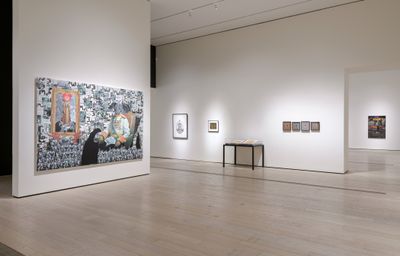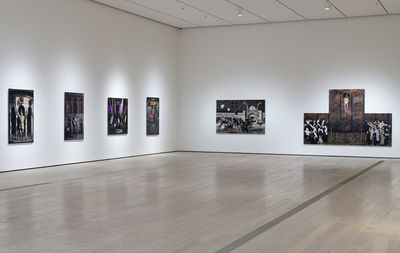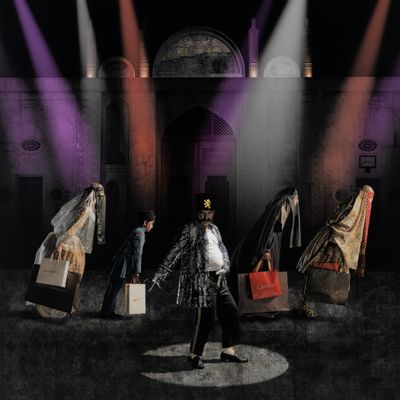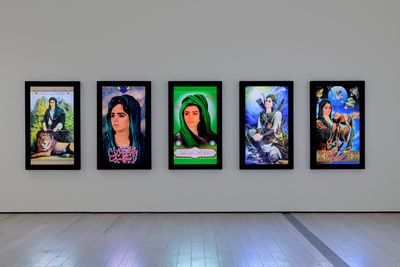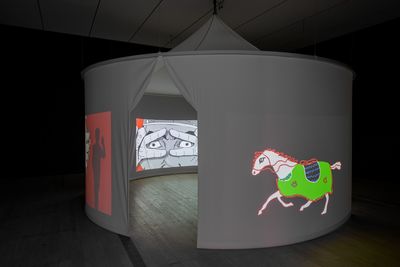Iranian Art at LACMA: In the Fields of Empty Days
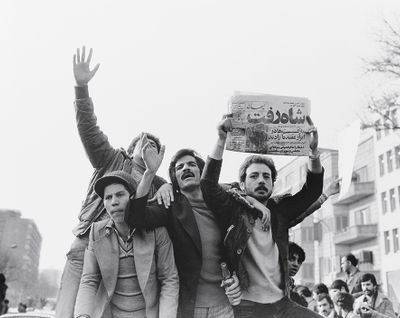
Kaveh Golestan, The Shah Left (1979). Printed 2015, gelatin silver print. 61 x 76 cm. Los Angeles County Museum of Art, gift of the Estate of Kaveh Golestan. Courtesy © Estate of Kaveh Golestan. Digital image: © Museum Associates/LACMA.
'In the Fields of Empty Days: The Intersection of Past and Present in Iranian Art' showcases Iranian art in the past and present tenses so that both might encounter one another.
In the Fields of Empty Days: The Intersection of Past and Present in Iranian Art at the Los Angeles County Museum of Art (LACMA, 6 May–9 September 2018), explores 'the continuous and inescapable presence of the past in Iranian society.' Curated by Linda Komaroff, curator of Islamic art and head of LACMA's Art of the Middle East department, the exhibition brings together historical and contemporary Iranian works of art, spans an entire floor and is divided into two sections: Kings and Heroes and Saints and Martyrs.
There is an overarching focus on the depiction of ancient kings and heroes as saints and Islamic rulers and their role in justifying and legitimising the ruling elite. 'Iran's adoption of Shi'ite Islam in the early 16th century also helped to fix the past irrevocably in the present through the cycle of remembrance of the martyrdom of Shi'ite Imams', writes the curatorial statement. 'Both of these strands—olden kings and heroes, and martyred Imams—carry forward, even sometimes overlap, in contemporary Iranian art, rendered anachronistically as a form of often barely disguised social commentary.'
Some 125 works by over 50 artists—ranging from painting, sculpture, video and photography to historical illustrated manuscripts, animations, and political cartoons—are on view, nearly half of which come from the museum's permanent collection. A number of works in the first half of the exhibit reference the Qajar era (1785–1925), in particular the assassination of Nasir al-Din Shah, King of Persia (r. 1848–1896), and the 1979 Iranian Revolution and prior reign of Mohammad Reza Shah (r. 1941–1979). Archival documents such as Antoin Sevruguin's portrait of Nasir al-Din Shah Sitting on the Lower Step of Takht-i Tavus or the Peacock Throne, taken in the late 19th century, and several manuscript paintings from Iran's national epic, the Shahnama (1010), are on view; many emphasise the story of Rustam, a hero who goes through seven acts of labour, such as a mid-17th-century painting by Mu'in Musavvir, titled The Div Akvan Carries Rustam to the Sea.
The first room of the exhibition is practically given over completely to Siamak Filizadeh's 'Underground' series, which draws from Nasir al-Din Shah's reign and assassination. Walls are covered in large, digitally manipulated photographs portraying the Shah or his assassin in present-day or historical settings. Return from Europe (2014), for instance, characterises the Shah as Michael Jackson, while three women and a young boy behind him bend forward, weighed down by shopping bags embossed with the logos of luxury brands. Nasir al-Din Shah was the first Iranian ruler to visit Europe, completing a total of three opulent trips during religious and social turmoil, which saw calls for reforms which he refused. (He did withdraw from his 50-year tobacco concession to Great Britain on the purchase, sale, and processing of tobacco in Iran, but not without initial government intervention amidst the protests and forced removal of key figures against the concession.)
It is said that the last words of Nasir al-Din Shah were a promise to rule differently if he survived what became a successful attempt on his life. On LACMA's acquisition of Filizadeh's 'Underground' series earlier this year, Komaroff wrote on LACMA's blog: 'As the lessons of history have shown, and as the artist subtly suggests, part of the great tragedy of Nasir al-Din Shah's reign is that the same types of mistakes were repeated under his successors, royal and otherwise.'
The same idea—that the mistakes of the past have been repeated time and again—haunts In the Fields of Empty Days. Further along the Kings and Heroes section, and easily missed in a room full of works that include archival black-and-white photos of protests (1978–1979) during the Iranian Revolution by notable photographers Abbas Kiarostami and Maryam Zandi, are Ardeshir Mohassess's simple drawings from 1977–1978, which situate figures such as Mohammad Reza Pahlavi and Ayatollah Khomeini as mid-19th to early-20th century Qajar rulers. Temporalities conflate in subtly grotesque and satirical images like The king is always above the people (1978), in which a king is shown hanging from the gallows, quite literally above the people. This typically sardonic piece uses distinctly Qajar imagery—characterised by the use of a variety of ornate headwear such as turbans and caps and loose, layered robe-like garments—to refer to the impending demise of the Pahlavi dynasty under Mohammad Reza Shah in January 1979. Along the wall across from Abbas' and Zandi's works hang multiple drawings by the former caricaturist, all in thick, dark ink, that, upon closer inspection, contain 'quirks' such as bullet holes, flaming turbans, and headless clerics.
In her essay 'Ardeshir Mohassess Painter of History', Shirin Neshat, who is also featured in this exhibition, writes: 'In many ways, an overview of Mohassess' art facilitates an understanding of the modern political history of Iran in the 19th and 20th century: a history that proves to be overwhelmingly dark and authoritarian. Mohassess' depiction of Iranian rulers over this timespan reveals the devastating truth that the tragedy of Iran seems to repeat itself, with no escape.' Neshat goes on to assertively state that Iran will only find its true identity when it acknowledges its past, with Mohassess' art offering a prime example of an artist's insistence on identifying historic repetitions and representing them in earnest. Neshat's series of black and white photographic prints, 'The Book of Kings' (2012), demonstrates this in turn. Amir (Villains) depicts a bare-chested man with images of an ancient battle scene from an early-20th century lithograph edition of the Shahnama made to look like tattoos across his upper torso__. Neshat has attributed contemporary political demonstrations in Iran and the Middle East, such as the Arab Spring and the Green Movement, as influences on the series.
The Saints and Martyrs section of In the Fields of Empty Days exhibition acknowledges—and challenges—notions of repetitive, cyclical histories much more directly. References to Shi'ite Islam, which Iran adopted in the early 16th century, are especially prevalent. Shi'ite Islam is known for memorialising the martyrdom of Shi'ite Imams or leaders, particularly through passion plays known as ta'ziya, where graphic re-enactments and rituals take place to properly mourn martyrs such as Husain, the grandson of the Prophet Muhammad who was murdered at the battle of Karbala in 680. (That 680 battle is historically understood as the event that saw Islam separate into Shi'a and Sunni sects.) Opening this part of the exhibition is Shoja Azari's 'Icon' series (2010): five video portraits that take influence from Shi'ite posters of saints once popular in Iran, with the faces of male saints replaced by video portraits of women. These memorialise mothers who have lost children, particularly during Iran's 2009 Green Movement, and level distinctions between saintly, holy figures and regular people.
Yet, while Azari seems to state through these portraits that anyone can be a martyr, anyone can suffer, and that memorials should not be relegated to the saintly, on first glance his 'Icons' seem to replicate the hierarchy created by such religious visual representations. The viewer and figure remain relegated to different spheres, one gazing at the other, who is rendered as a lavish, colourfully bold and unearthly object of worship. Yet, the framing of each face and the use of video rather than static portraiture, creates a heightened intimacy; a tear falling from an eye becomes a mortal reminder of our common human vulnerability.
Artist Pouya Afshar also makes reference to Karbala, while considering forms of Persian and Muslim Shiite mourning rituals in his video installation Mourn Baby Mourn (2017): a massive white tent housing four projectors screening the same video animation played simultaneously, albeit starting at different times. The narrative entangles personal and larger cultural threads into what the artist calls a 'virtual theatre' that expresses the same emotional intensity of a passion play. Throughout the film, the camera follows a young boy witnessing a massacre and a grieving community that seeks emotional relief after experiencing trauma. Mourn Baby Mourn is a bold and fitting conclusion to the exhibition as a whole; it considers how communal traditions and rituals, as shown in the collective grief in the film, might offer a remedy to witnessing and re-living painful histories again. In many ways, Afshar's open tent is a microcosm of the exhibition itself: at once a housing of violent histories, and a home for mourning together.
In the Fields of Empty Days: The Intersection of Past and Present in Iranian Art showcases Iranian art in the past and present tenses so that both might encounter one another, while facilitating encounters in turn. But the elephant in the room, despite thisconvergence of past and present, is the future. Many of the contemporaryartists included in the show could not install their work or attend the exhibition opening due to travel ban restrictions, and rightnow, it is uncertain what will happen as a result of the United States's recent exit from the 2015 Iran deal, recalling the convoluted and chaotic relations between the two countries. The show's timeliness—and thesignificance of this being staged in an American institution today—is not loston viewers at a time when American-Iranian relations are strained to say theleast. To this end, the exhibition offers an American audience some insight into Iran's histories of trauma, while similarly reflecting on their resonances now.
What emerges are the many questions that In the Fields of Empty Days implores its viewers to consider. What is to be done with all this historical memory, trauma, and documentation? If the field is filled with empty days, what becomes of them when the emptiness that lies ahead is indistinguishable? If the past becomes a literary, symbolic, and abstract device to interpret the present, are we caught in a cycle of remembering the present, thereby never being able to visualise a future? —[O]

